The harmonica and guitar – a perfect combination!
Neil Young, Bob Dylan, Bruce Springsteen. If these names remind you of a harmonica, making you want to put a support close to your mouth and play your favorite songs with these two instruments together, today, I’ll explain how to do it. With this guide, you’ll learn everything you need to start becoming a real one-man band, and will be able to practice a couple of very effective exercises.
The Harmonica And Guitar – An Introduction
Why Learn The Harmonica And Guitar Together?
Do I Need To Learn The Guitar Or Harmonica First?
How Long Does It Take To Play The Guitar And Harmonica Together?
Harmonica And Guitar Gear – What Do I Need?
What Kind Of Guitar Is Better To Play With The Harmonica?
What Other Accessories Do I Need To Play In One-Man Band Style?
The Harmonica Neck Rack Holder, Which Is The Best To Utilize?
What Kind Of Harmonica Should I Use?
The Harmonica And Guitar – A Practical Guide
The Right Way To Approach Studying The Guitar And Harmonica Together
Chord Sets And Usage Of The Guitar Capo
Simplified Chord Sets
Strumming And Arpeggios
Single Notes And Chords
Playing In Different Positions
Combining The Harmonica And Guitar
Choosing The Chord Set, Harmonica Key, And Position
Harmonica And Guitar Exercises
Strumming The Chords And Playing A Melody On Harmonica
Playing The Same Notes On Both Instruments
WHY LEARN THE HARMONICA AND GUITAR TOGETHER?
When the idea of putting the harmonica and guitar together began to creep into my brain, I wanted to do some accurate research about the musicians, in my country and over the rest of the world, who played them at the same time in a decent way. I say ‘in a decent way’ because I was aiming high; I didn’t just want someone playing the harmonica while strumming two guitar chords, but rather someone who could play the two instruments together to a certain level.
The first thing I did was ask one of my harmonica teachers (David Barrett) if he could give me the name of some American rack harmonica players; after all, harmonica in the United States is very common, so I thought this would be the place to look first. What a shame! My teacher couldn’t give me a single name, and the online research I did led me to only two artists: an Australian named Mitch Grainger and an American named Jimi Lee. These are the two harmonica players who play harmonica and guitar together in a wonderful way. In particular, I can say that Jimi Lee plays the harmonica on the rack almost as if he had it in his hands, and I assure you that this is very difficult. Watch Jimi Lee in action in the following video, as introduced by Adam Gussow.
Mitch Grainger plays a lot of blues songs, while Jimi Lee prefers jazz swing songs and also uses harmonicas with particular note layouts. He also plays diatonic harmonicas with valve systems that allow him to obtain some notes that would normally only be obtained with the overblow technique.
These two musicians inspired me during the first year I tried to understand how best to work my acoustic guitar and harmonica in synergy. I contacted the aforementioned musicians (at that time, I still thought someone would want to give out some tips) and got some advice that I can summarize in two sentences: "It takes months" and "Congratulations!" So, I had to work out everything for myself. Later on in my journey, I found myself in a situation where I really understand that nobody should be expected to help you for free – now I’m on the other side of that river!
I immediately realized that I would have to learn to play the guitar decently first by myself, as I had already played the harmonica for years. I did three years of separate study, trying to learn as many different techniques as possible on the guitar – strumming, arpeggios, walking basses – and decided to play with my fingers, leaving the pick after the first year. The guitar teachers I chose each gave me something different, but almost my whole journey focused on fingerstyle: I like to pinch strings and play chords by skipping some of them, and you need your fingers rather than a pick to do this.
So why play the guitar and harmonica together? Personally, I decided to do it because I can express myself in a complete way, doing the solos with the harmonica and accompanying myself with the guitar. If you just play the harmonica and don’t sing, your range will be limited, but if you put it with the guitar, it opens up a whole new world with many more possibilities. Add the singing and you’re away – I did it!
DO I NEED TO LEARN THE GUITAR OR HARMONICA FIRST?
It doesn’t matter if you learn to play the guitar or harmonica first – what matters is that you learn to play them well separately before you put them together. Remember that the instrument you play worse will lower the average level when you play it together with the other.
HOW LONG DOES IT TAKE TO PLAY THE GUITAR AND HARMONICA TOGETHER?
Only when you have enough mastery of the technique of each of the two instruments can you begin to work on what actually becomes a third new instrument. What I’m saying is that when you put the guitar and harmonica together, you’re not just playing them on top of each other, you’re playing them with each other. The difference is huge. If you get a guitarist who hasn’t studied the harmonica enough on his own, the type of performance he can create will be decidedly elementary. You would get the same result in a harmonica player who, before putting the two instruments together, didn’t study the guitar by itself much beforehand.
I spent 4 years studying harmonica and learning to play it at an advanced level, working with real teachers, practicing two hours a day, and attending workshops; it costed some money too, but I can now assert that it was worth it. Then, I studied the guitar alone for 2 years. Finally, I put them together, and it took 2 years to play them well at the same time. Ideally, if you carry on the study of the two instruments separately from the beginning, in 4 years, you can become a good one-man band. Of course, these indications are very general – for some people, it may take many years, especially if they’re self-taught. If you want to learn well, I recommend that you study seriously with a teacher or with some well-structured online courses. As far as the harmonica is concerned, my courses can definitely help in this regard.
WHAT KIND OF GUITAR IS BETTER TO PLAY WITH THE HARMONICA?
The type of guitar I suggest playing with the harmonica is the acoustic one, and even better if it’s electrified. Keep in mind that the volume of the harmonica is usually higher than the guitar, so if you buy an acoustic guitar with a small body, you’ll need to amplify it to balance the two volumes.
WHAT OTHER ACCESSORIES DO I NEED TO PLAY IN ONE-MAN BAND STYLE?
Among the guitar accessories you’ll need to buy to play with the harmonica, there’s definitely the capo. With this accessory, you can easily choose the tonality of the song in which to play and the most suitable set of chords.
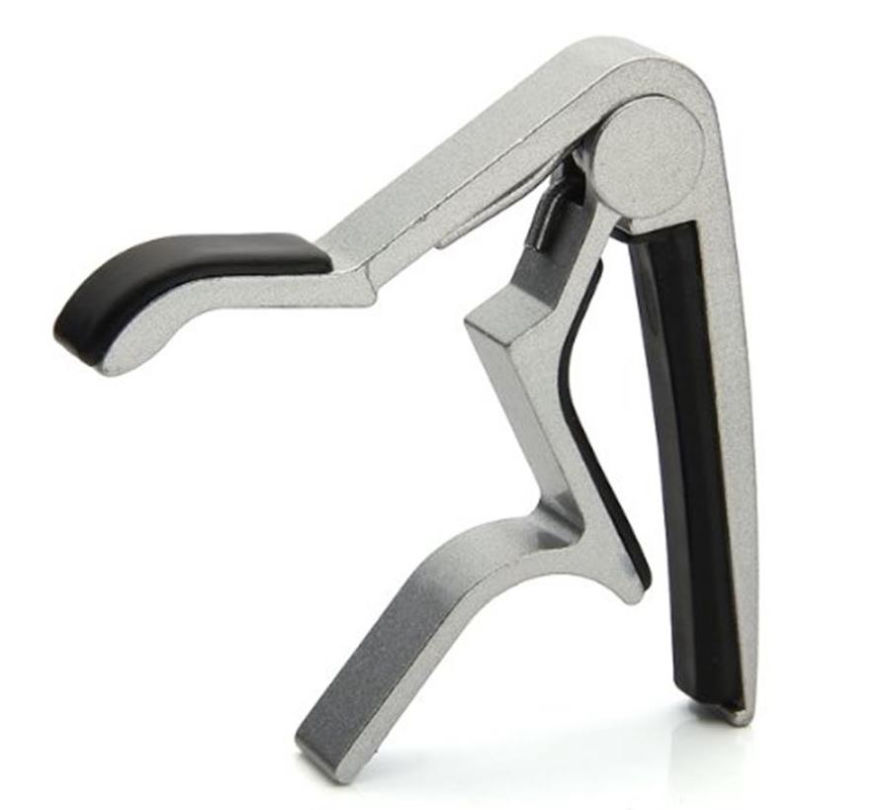
THE HARMONICA NECK RACK HOLDER, WHICH IS THE BEST TO UTILIZE?
The key accessory for playing the guitar and harmonica together is the harmonica support, also called a neck rack. I’ve tried many, and what I recommend (and which I’ve used daily for years) is the Hohner Flexrack, which you can find here. This support costs quite a bit, but I guarantee that it’s safe, reliable, sturdy, and above all, allows you many adjustments. I don’t recommend using thin metal supports with low-quality adjustment screws. There are many of these cheap gadgets on the market, so be careful!
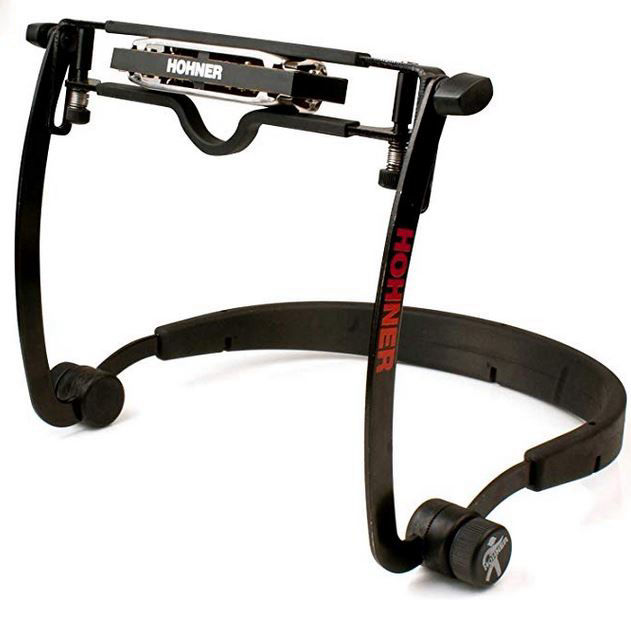
WHAT KIND OF HARMONICA SHOULD I USE?
With the guitar, a diatonic harmonica is what you need. Obviously, playing a chromatic harmonica with the guitar would be quite difficult, since you wouldn’t have a free hand to push the harmonica slider, when you want to raise the note you’re playing by a semitone. In terms of models, on the Hohner Flexrack, harmonicas like the Hohner Special 20, the Seydel 1847, and the Hohner Crossover, work very well and are firmly held by the rack. I don’t recommend the Suzuki Harpmaster harmonica, as it tends to slide out from the support.
THE RIGHT WAY TO APPROACH STUDYING THE GUITAR AND HARMONICA TOGETHER
As I said before, the approach you want to have is to study each instrument separately before combining them. What you want to achieve is not to play the same notes you play on the guitar on the harmonica, but to combine the two instruments to create a wonderful mix, where the guitar creates the backbones of the song and the harmonica acts as the soloist role. There will be also moments in which you play fast licks with both the guitar and harmonica, and this is really effective, but most of the time, the guitar and harmonica will have two distinct roles. When you put these two instruments together, you will have a new instrument that’s not the sum of the two, but rather a whole world apart.
The purpose of this tutorial is not to teach you how to play the guitar or harmonica. In this second part of the lesson, I’m assuming you already know how to manage to play chords and arpeggios, so the following sections will help you to combine the two instruments more easily.
CHORD SETS AND USAGE OF THE GUITAR CAPO
What is a chord set? Let’s follow an example. You can play a C major chord, shaping it on the first three guitar frets, or you can play it by shaping an E major chord with a barre on fret 8. You could use a capo on that fret and shape the E major chord without the need to make the barrè with your index finger.
When you play a song, you use the chords that come from the harmonization of its reference scale – for example, when playing in C major, you have: Cmaj7, Dmin7, Emin7, Fmaj7, G7, Amin7, Bdim. You can play these chords in the first position on the guitar, or you can use the barre (or capo) and use a different set of chords.
Let’s use another example to clarify this important topic: you want to play a C major song but use the G major chords set, because you know some nice arpeggios on those, can put your capo on the fifth guitar’s fret, and play the chords Gmaj7, Amin7, Bmin7, Cmaj7, D7, Emin7, and F#dim. The capo will transpose all the chords to make you play in the C major key.
There are different variables that you need to take into consideration when choosing a chord set – among these, which guitar string you want the bass note to be located on, and the type of technique you want to apply in playing the guitar part. Basically, each chord set offers some advantages. For example, the E chord set is very effective when playing blues, whereas the C and the G chord sets are good for playing major songs. For minor songs, the E minor or A minor are the best options.
These are some good combinations using the capo and chord sets:
Song key C major, chord set C, not using the capo.
Song key D major, chord set C, placing the capo on guitar fret 2.
Song key E major, chord set C, placing the capo on guitar fret 4.
Song key G major, chord set G, not using the capo.
Song key A major, chord set G, placing the capo on guitar fret 2.
Song key E minor, chord set E minor, not using the capo.
Song key G minor, chord set E minor, placing the capo on guitar fret 3.
Song key A minor, chord set A minor, not using the capo.
Song key B minor, chord set A minor, placing the capo on guitar fret 2.
What about other song keys? Basically, you want to use one of the above combinations, moving the capo on a different fret. For example, for a G# major song, you can use the G chord set, placing the capo on the first guitar fret. Personally, I try not to place the capo beyond fret 4.
The image below is of my personal chord set and capo placement to play the guitar and harmonica together.
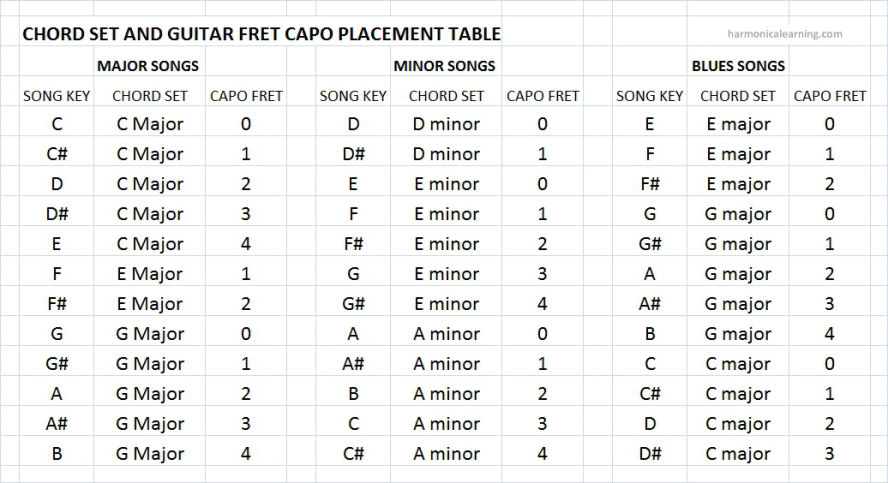
A brief note about using the capo: some guitar players consider using the capo to be cheating, because it simplifies the way you play the chords. In my opinion, learning to shape chords with the barrè is correct, but when it comes to playing the guitar and harmonica together, we want to simplify what we do with the guitar because our brain must manage many different tasks at the same time. Feel free to play the guitar how you want, as long as you can play the chords you need and feel comfortable doing so.
SIMPLIFIED CHORD SETS
As I just mentioned, when playing the guitar and harmonica together, it’s preferable to simplify certain things, and during my rack harmonica playing career, I developed a personal simplified C chord set that works very well if you play using the fingers in place of a guitar pick. The following image shows this chord set.
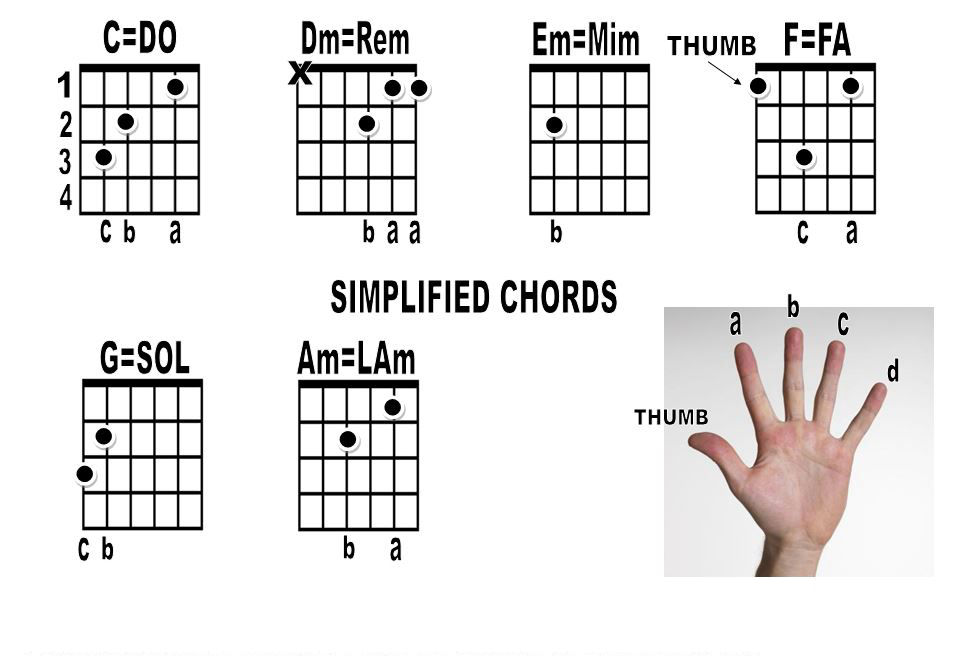
STRUMMING AND ARPEGGIOS
It’s clear that the more guitar techniques you can use, the better your performance will be! The minimum you want to have in your guitar playing arsenal is to be able to play strumming and arpeggios.
SINGLE NOTES AND CHORDS
If you want to play the harmonica and guitar at the same time, you need to learn how to play single notes on the harmonica. If you can do this and can play in different positions, you already know that the particular note layout on the blues harp makes things easy when playing in first position, like on a C song with a C harmonica. However, if you play in other positions with the harmonica, you can’t always benefit from the double note combinations. As for the guitar, the more skilled you are with the harmonica, the better your performance will be. Learning to play the basic chords on harmonica is also very useful – you can focus on the first three harmonica holes to play the first and the fifth position chords.
PLAYING IN DIFFERENT POSITIONS
Once you’ve chosen your guitar chord set and placed the capo on the necessary guitar fret, you need to choose what position to play the harmonica in and pick the correct harmonica key – take, for example, the following picture:
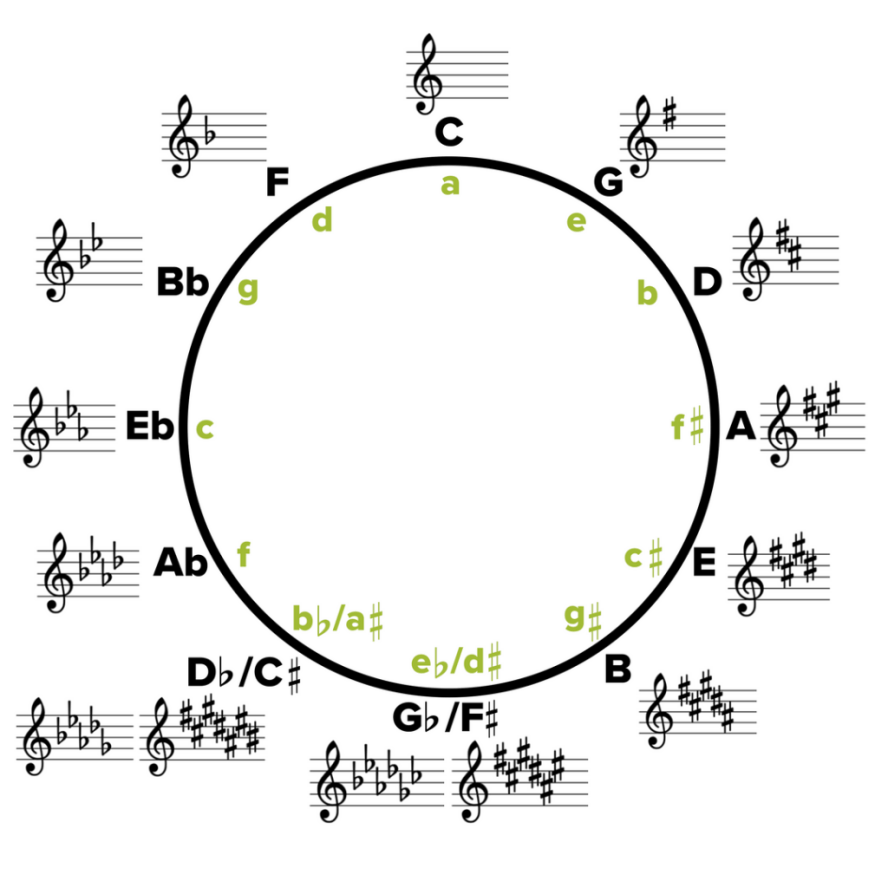
This picture is a representation of the twelve keys in which we can play. Starting from the top, we have C, then moving clockwise, we find G, then D, and so on. What does the term 'playing in second position' signify? Simply take the key of the song and that of the harmonica and count them to figure out the number of positions that lie between the harmonica key and that of the song itself. For example, if the track is in D and we use a C harmonica, we count C, G, D to conclude that we’re playing in third position. Note that both of the positions – the one occupied by the harmonica key and the final position of the piece – are also included in this count.
Let's look at another example: a B flat harp playing an F song. We count clockwise and have B flat and F, which shows that we’re playing in second position. One final example: let's take the C harp and play an E song; it will be in fifth position and the keys in focus here are C, G, D, A, and E.
You can find a detailed lesson on harmonica positions here.
The following pictures show the notes you can play in first and second position on the harmonica.
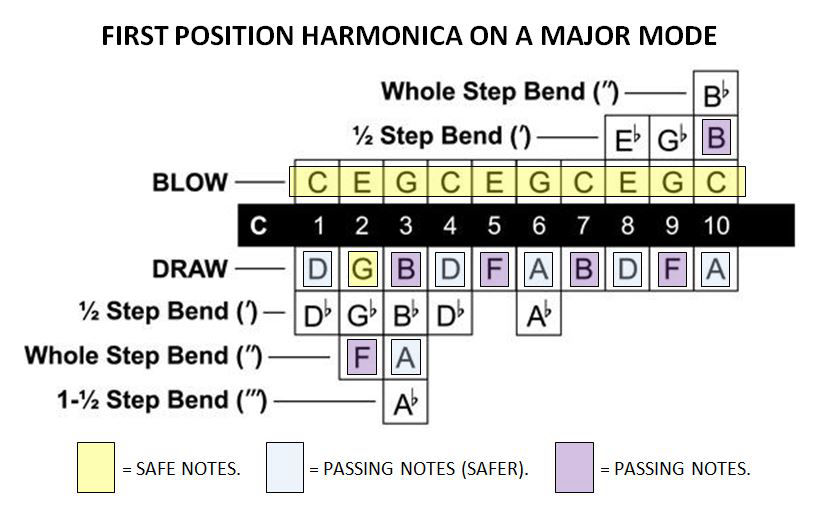
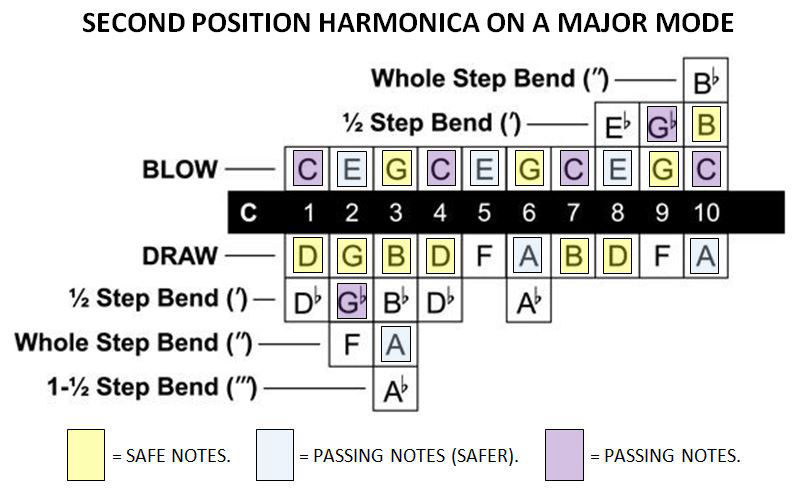
CHOOSING THE CHORD SET, HARMONICA KEY, AND POSITION
Some positions are effective to play WITH major songs, others on minor songs, and some best suit blues songs. Below, on my personal harmonica positions chart, I added the harmonica key and position to the guitar chord set table, to have a complete one-man band reference table for each type of song: major, minor, and blues.
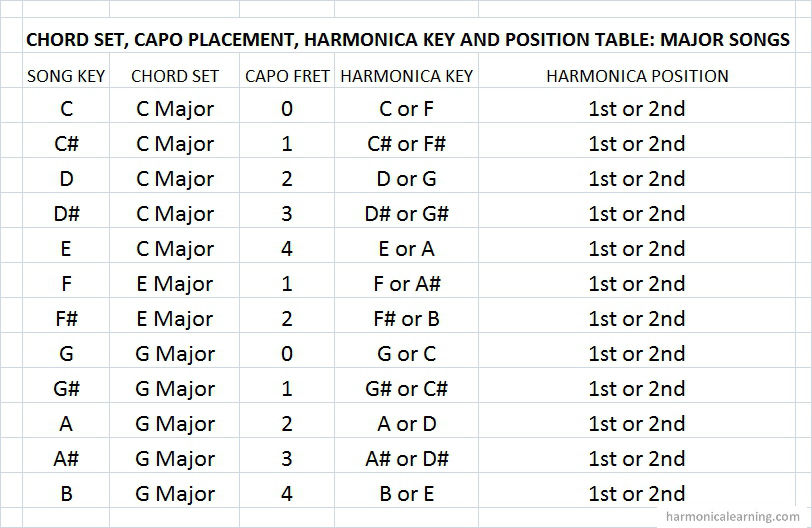

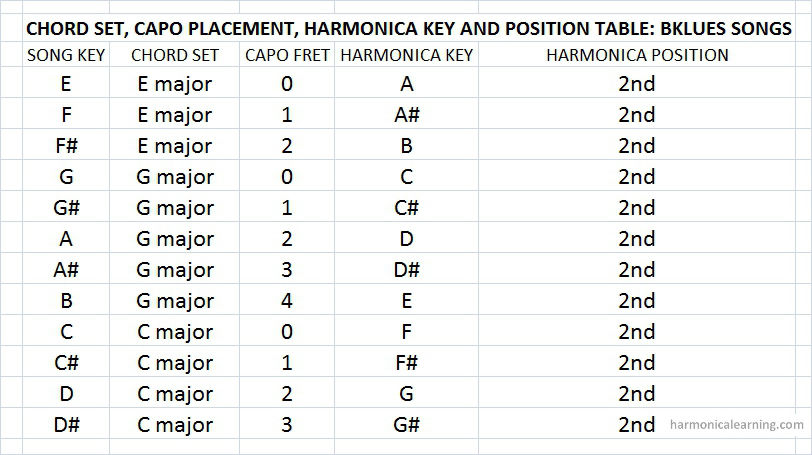
HARMONICA AND GUITAR EXERCISES
In this section, I want to share some exercises that I believe are fundamental if you want to play the harmonica and guitar together. Remember, you want to develop coordination and independence of the two instruments first. The first issue you’ll encounter will be that you’ll start to blow in your harmonica whenever you strum down on the guitar chords and inhale when you go up! Here are the exercises.
STRUMMING THE GUITAR AND PLAYING A MELODY ON THE HARMONICA
This is the first exercise – playing the C major scale on the harmonica using holes 4 to 8, while strumming a C major chord on the guitar. You’ll use a C harmonica and play in first position. The first time, you’ll start playing the harmonica on the down strum, then on the up movement. Here are the harmonica tabs:
4+, 4, 5+, 5, 6+, 6, 7, 7+, 8, 7+, 7, 6, 6+, 5, 5+, 4, 4+
PLAYING THE SAME NOTES ON BOTH INSTRUMENTS
The second exercise you should practice is playing the same notes on both the harmonica and the guitar. The harmonica will play the same notes of exercise 1, while on the guitar, you’ll play the C major scale starting on the 5th string, fret 3. In the second version of the exercise, I played eight notes on the harmonica to make this more challenging. Give it a try!
SHARE THIS GUIDE WITH YOUR HARMONICA FRIENDS!